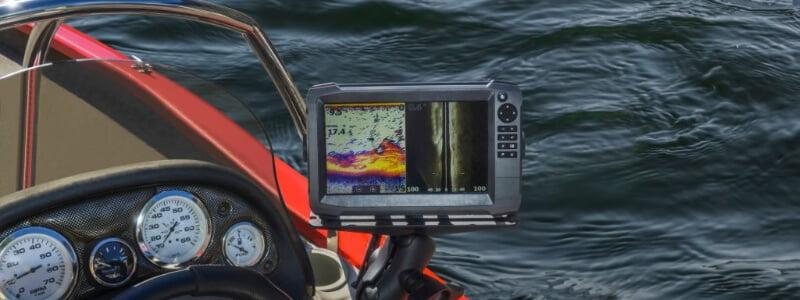While there are no guarantees of a successful catch after spending a day on the lake, river, or sea, using a high-quality fish finder or depth finder can greatly increase your chances. These devices allow you to determine if the area you plan to fish is populated with fish. This will help you make good decisions about where to deploy your equipment and how to adjust your fishing strategy.
In recent years, fish finders have become accessible to anyone who wants to dabble in fishing. Famous brands such as Garmin and Lowrance offer the best fish finders under $300 with the latest and innovative technologies.
Whether you prefer fishing from a canoe, kayak, boat, dock, or shore, you can find an excellent fish finder under $300 from our list. In the following guide, we also include all the necessary information you need to consider before making your purchase decision. We dedicate a significant amount of time to research because we prioritize recommending high-quality models at a reasonable cost.
Best Fish Finders Under $300 Reviews 2024
The best fish finder under $300 is Humminbird 410210-1 HELIX 5. The latest Humminbird 410210-1 HELIX 5 comes packaged in the Humminbird portable kit. This is a portable CHIRP fish finder, with a beautiful design. It has a bright 800×480 pixel clear display.
However, let’s explore all recommendations step by step…
1. Humminbird 410210-1 HELIX 5 CHIRP GPS G2 – Top Pick
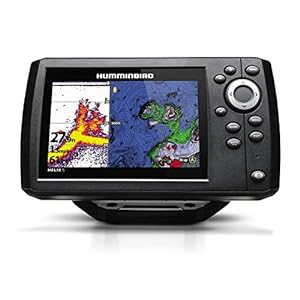
The Humminbird 410210-1 HELIX 5 is the best fish finder under 300 on the market today. It built basemap with excellent frequency. Whether you are a professional angler in freshwater or at sea, this advanced fish finder allows you to locate great precision schools of fish and underwater soils for a better experience. This is a versatile device, suitable for boats, freshwater lakes, coastal and ice fishing.
This device works to a maximum depth of 2500 feet, making it ideal for fishing any season. It has a detection frequency of 250 kHz with a CHIRP Dual sonar beam. The flasher mode is very responsive with lots of different screen options. The updated GPS feature helps you to relocate spots on the lake.
There are multiple inputs so that you can connect the underwater camera to the device. With the 5-inch color display, their enhanced standard BaseMap provides you with a clear view of underwater terrain and surrounding points of interest, so you can find fish and navigate with high confidence. The compact design will fit easily into your pocket or tackle box.
Humminbird HELIX 5 fish finder comes with transducer and necessary mounting brackets and cables. You can run the wire through the scupper, but the actual transducer will have to be mounted.
PROS
- Great screen definition
- GPS enable features
- Everything is included in the package
- Easy to use, set up and carry
- Built-in two display modes – Max and Clear
- It has a micro SD card slot for optional maps
CONS
- Doesn’t come with a screen cover
- There is no side-view scan
- Technical aspects of the unit take time to learn
2. Garmin Striker Plus 5cv with Transducer – Editor’s Choice
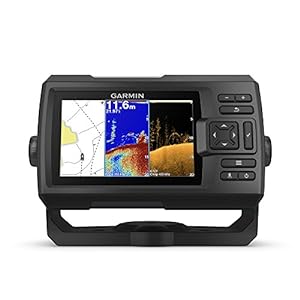
Garmin has established itself as a household name among anglers worldwide, known for its reliable fish finders that aid in identifying target fish. If you need a fish finder that efficiently probes the seabed and detects fish formations with accuracy, you can rely on the Garmin Striker Plus 5cv and the quality of its sonar beams.
Let’s talk about the features that the device offers; Garmin Striker Plus fish finder has a 5-inch bright display and built-in GPS features. It will provide more precise information. The bright and sunlight-readable display ensures clear views of what is below your boat or kayak, even on extensive sunny days. The big screen gives you a better view of what is happening below the boat.
This device is extremely easy to operate, even if you don’t have previous experience on how to operate a fish finder. The intuitive user interface makes this fish finder simple to navigate. The high-sensitive GPS will maintain your position anywhere you go on the water. The latest GPS further allows you to mark waypoints for different locations. So, if the fish are biting in 1 spot, you just mark it and return to it on your next trip.
CHIRP ClearVü scanning sonar and Quickdraw Contours map drawing software stores up to 2 million acres of content with 1’ contours. However, there are no charts available for the Striker Series. But you can make your own contour maps or download them from other users. It doesn’t have a cover, but you can mark spots with it.
PROS
- Very easy to maintain and use
- Built-in high-quality materials
- Excellent design and structure
- Sunlight-readable display
- Very reasonable price
CONS
- Doesn’t include complete instructions
- It is not a portable device
3. LUCKY FF718LiC Wired & Wireless Portable Fish Finder
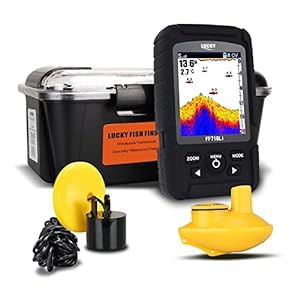
If you’re looking to enhance your chances of catching fish without the hassle of complicated setups, the LUCKY FF718LiC is an ideal device for you. Combining exemplary ease of use with advanced features, it is one of the best castable fish finders in its price range on the market. It offers both wired and wireless modes and provides versatility and convenience for all types of fishing scenarios.
The LUCKY FF718LiC comes floating design, troll from any kayak or boat fishing, and a rechargeable battery with 10 hours of continuous use on a single charge, fresh and saltwater operation. This device is also optimal for those looking for a small-depth portable fish finder under $200.
It is suitable for varied fishing environments. For example, it can be used for boat fishing, ice fishing, lake fishing, marine fishing, and so on. This model is also suitable for shore anglers because its unbeatable range and scanning depth help to find the structure to mark fish.
It comes with a USB cable so that you can charge it with USB via computer or other electrical devices. Although it is a small device, the 2.8-inch LCD screen provides quality images with different screen modes. If you are a beginner, starting kayak fishing, or just looking for a cheap wonderful quality compact fish finder, then look no further.
PROS
- Wired & wireless mode portable fish finder
- Great choice for many fishing
- Pretty accurate and compact
- Battery life is dominant
- Best entry-level fish finder
- Cheap price
CONS
- Doesn’t come with a plugin charger
- Small display
4. Deeper PRO+ DP1H10S10 GPS Wireless Fishfinder
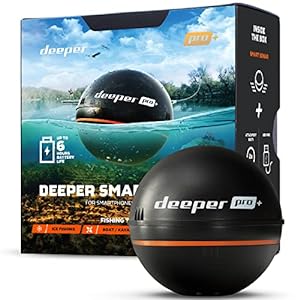
Deeper Pro Plus DP1H10S10 fish finder doesn’t need a visual display at all. You can simply install the app and view the donor’s data on your smartphone. Thanks to the synchronization via Wi-Fi, you don’t need Internet access; the connection is secured up to a distance of 100 meters.
It is equipped with a GPS so that users can follow their steps after the day of fishing. The data will be saved automatically in a cloud, whereby the device automatically creates an underwater map. The stored information is accessible to you at all times, so you can find the noted hotspots at a later date.
Deeper Pro Plus fish finder is suitable for bank, ice, kayak, and boat fishing as long as you do not exceed temperatures of -20 to 40 degrees Celsius. With a maximum depth of 80 meters, even fishing in deeper waters is possible. But you will get the most accurate readings when the depth is between 0,5m to 80m.
You have the choice between two frequencies and the associated radiation angles. The large beam angle is suitable for a rough overview and the acquisition of approximate data. In contrast, the small beam angle provides you with exact information about a small area. The dual-beam system guarantees you flexible use for the respective area so that you always achieve successful prey.
PROS
- Excellent graph and flasher capabilities
- You can use it to navigate unfamiliar waters
- Easy-to-use App with many features
- No wires and Dual beam
- Good neoprene pouch
CONS
- Doesn’t come with the orange cap for more visibility
- Not handy for night fishing
5. Humminbird 410190-1 Helix 5 Series Sonar G2
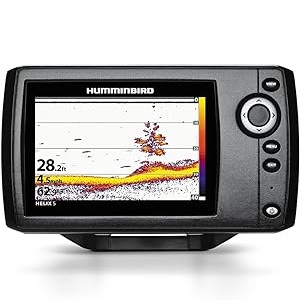
If you are looking for the best fish finder under 300 dollars with all the bells and whistles, then the Humminbird 410190-1 HELIX 5 is the best option for you. This model is the previous version of Humminbird 410210-1 HELIX 5. However, the built-in quality is almost the same.
This device includes the 3 types of sonar – DualBeam, Down Imaging, and Side Imaging. With a large 5-inch color screen, it is the first in the HELIX series that offers large and clear images. To ensure a successful fishing trip, it will provide precise information on your fishing. All the Helix series fish finders also have a port so that you can insert your nav card. However, there is no speed sensor.
The powerful transducer with CHIRP and temperature control makes all aspects of imaging very simple and no fish will be safe from being found. It comes with two display modes, Max mode, and Clear mode. The clear mode is suitable for beginner anglers. You can choose how you want to view the seabed, depending on the precision you are looking for, or if you want to focus on schools of fish on the move.
This model comes with an IPX7 waterproof system, which is an additional advantage. You can run your helix off your trolling motor battery because it does not require very much power to run. Mounting the head unit is simple with the transducer. Humminbird depth finder uses GPS to track your speed which is very accurate. However, you need to power it with a 12-volt battery.
The ability to take a screenshot or record sonar is a handy feature, especially if you want to show/revise your images at a later date. The screen has an LED backlight, which offers great visibility at night or in direct sunlight. You can adjust the Screen Brightness Setting to ensure good display color in different environments. The menu is super easy to navigate without a lot of complicated settings.
PROS
- Dual Beam PLUS sonar
- 5-inch display color of 4
- GPS mapping system
- Excellent choice for the price
- Simple to use and setup
CONS
- Doesn’t have iPilot capability
- You need to buy batteries separately
6. Lowrance HOOK2 with SplitShot Transducer
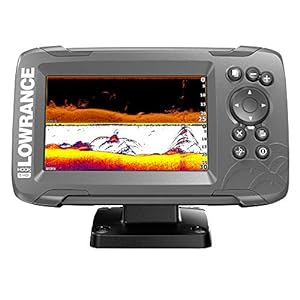
The next model comes from the well-known fishing gear manufacturer Lowrance. With Lowrance’s depth sounder, you don’t have to cast the lure into the water blindly. With a maximum depth of 152 meters, it is one of the most extensive fish finders under $300 on our list.
The full-color display of this device, panoramic, gives you a comprehensive overview of everything that is happening under your boat. The data display device is available with the appropriate mounting foot so that you can attach it near the encoder. You can get depth information on the display.
The two components are connected with a 5.5-meter cable, which guarantees secure data transmission. A temperature sensor is installed, which gives you the exact temperature. The temperature sensor always gives you information about the water temperature so that users can find fish more precisely.
The encoder sends a frequency of 200 kilohertz and the manufacturer promises wide-angle technology. You can set a depth alarm so that the device informs you when it is exceeded. The data display consists of a 4.3-inch display with a resolution of 480 x 272 pixels. The total weight is 1.76 lbs. The display is very precise and easy to read. The clear menu selection of the Lowrance fish finder promises you easy handling.
The Lowrance Hook2 fish finder has minimal GPS functions, which give you the ability to add speed over ground to the overlay data. It is suitable for boat and kayak fishing because of the stationary mounting method.
PROS
- Wider sonar coverage
- Speed is very accurate
- US inland lake maps installed
- One-touch access to key features
- Comes with everything you need
CONS
- Doesn’t have latest GPS feature
7. Garmin Striker 4cv with Transducer 4″ GPS Fishfinder
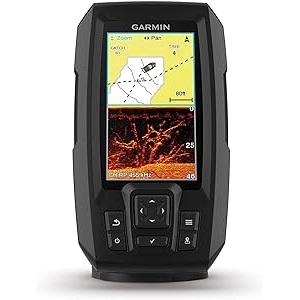
For those looking to enter the market with a small depth sounder, the Garmin Striker 4cv could be an ideal choice. It is one of the best fish finders under $300 for small boats or kayaks. It offers a great service for long time usage. The package comes with everything you need to install on your boat or trolling motor.
It is just a small and handy device. The screen is 4.3 inches, which provides high-quality images with different screen modes to display both sonar and GPS / maps at the same time. The backlight enables you to fish at night. This little beauty works wonders the imagery is sharp. The plot Charter is spot-on as well as the waypoints.
The dual-beam transducer is equipped with a temperature sensor, which is an additional advantage with several assemblies included. It has powerful depth capabilities and can be used abroad. So overall it is a versatile device that you can buy without breaking the bank.
Garmin Striker 4cv fish finder comes with multiple mounting options and a 20 ft transducer wire. This is very useful, especially for the versatility of use. It has a wide range of frequencies and scanning angles to analyze your environment adequately. It comes with a fuse. However, the battery connections are just stripped wires. You have to add the ends if you want to connect to the battery.
PROS
- Easy navigation system
- Speed display on the screen
- Rugged design for every fishing environment
- Great fish finder for the money
- Outstanding GPS feature
CONS
- Small size
- Included transducer cable is a little bit short
8. Deeper Chirp Smart Sonar Castable Fish Finder
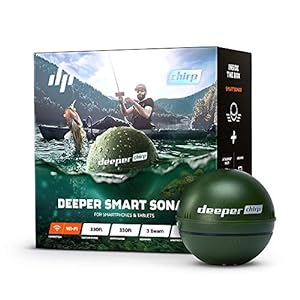
The Deeper Chirp Smart Wireless Sonar model paves the way for handheld sounders. It is portable and launchable chirp sonar and comes with an integrated GPS so you can take it anywhere. This is an ideal model for experienced anglers looking for a versatile device under 300 dollars.
Deeper Chirp Smart fish finder generates its own Wi-Fi signal to connect to your smartphone. The three-beam frequencies (47 °, 16 °, 7 °) allow you to scan larger areas first, then get closer to your chosen target or spot. It has 100 Meters depth finding capacity with stable connectivity. Precise scanning in water from 15 cm to 100 M deep and precise separation of 1cm targets.
The integrated GPS allows you to create bathymetric maps from the edge. Access all your scans, maps, points of interest, photos and notes on lakebook, your personal fishing journal. You can review, analyze, and plan your next fishing trip on any device from the comfort of your home.
This model is smaller than a tennis ball and weighs only 10.4 oz. This device displays all sonar readings directly on your phone or tablet and is able to see the fish, structure, vegetation, bottom relief and hardness. You will masterly know the depth and temperature of the water.
PROS
- Powerful and versatile
- Fast battery charging
- Excellent target separation
- Wi-Fi and GPS enable
- Casts out to 330ft with solid connectivity
CONS
- Can’t be hooked up to two phones at the same time
9. Lowrance HOOK Reveal 5x SplitShot Fish Finder

With a 5-inch crystal clear display, the Lowrance Hook Reveal 5x provides clear pictures of what happens under the water even at night. This device is suitable for various fishing environments. For example, it can be used for boat fishing, kayak fishing, ice fishing, lake fishing, marine fishing, and so on.
The depth range can be easily adjustable and display data in both feet and meters. You can easily navigate your favorite fishing spot with the GPS Plotter, which makes route, trail, and waypoint navigation easy. It will immensely reduce your sonar settings reworking time and ensure you get the best sonar image every time by automatically adjusting settings.
The Lowrance HOOK Reveal 5x is one of the best fish finders under $300 on the market in terms of durability and clarity. It’s easy to use and set up. It detects and shows the depth of the water, the approximate position of the fish, short and tall weeds, sand, and the rocks on the bottom.
You can mount the transducer to your float tube hull if there is a position for you to fix it. Once you become familiar with various controls, this device will fully meet your expectations. All the cords and brackets come with it. The cables are about 15 feet. However, it is a non-mapping plotter, so no mapping content is included with this model. This device also works in murky water. You can adjust sensitivity to make it adaptable to this environment.
PROS
- Suitable variety of fishing environments
- Long-lasting durability
- Sensitive fish finder
- Large and clear display
- Easy to navigate and set up
CONS
- Doesn’t come with cover
- No mapping option
10. Garmin STRIKER PLUS 4cv Bundle CV20-TM

The Garmin STRIKER PLUS 4cv fish finder, ranking tenth on our list, offers versatility for use in various water bodies, including the sea, lake, or river. Its increased flexibility makes it suitable for fishing from ice, kayak, shore, or boat and provides anglers with reliable performance across different fishing environments.
The large beam angle and the high frequency enable you to cover a large area so that you are sure to catch a fish in shallow water. You can use this device to a depth of 44 meters.
The transducer cable length is 20 feet. It is equipped with an alarm that is activated when the fish approach. It has a mounted hook that can be rotated both vertically and horizontally. This device has a sonar and traditional fish finder split screen.
The STRIKER PLUS 4cv fish finder package includes a cover, small stand, and transducer, providing anglers with essential accessories for their fishing adventures. The GPS capabilities allow users to save waypoints for future reference. Despite its compact size, it excels at displaying both structure and fish.
This handheld fish finder provides precise information for a successful fishing trip. It also built a quick disconnect feature so that you can easily remove it. However, it doesn’t have the top-down view; you have to get the 7 or 9-inch ones for that. Also, screen brightness doesn’t seem to hold every time.
PROS
- Quickdraw Contours mapping software
- Instructions are explicit
- Comes with more features
- Energy-efficient design
- Lightweight and compact
CONS
- Water-resistant but not waterproof
- Does not have an internal battery
How to choose the fish finder under 300 dollars
As outlined in our guide, fish finders vary significantly, so it’s essential to choose a device that suits your specific needs, preferences, and skill level. By reading this guide, you’ll gain insight into all the important factors to consider when purchasing the best fish finders under $300.
The depth
For each model of fish finder, manufacturers specify the depth range it can effectively operate in and the quality of data it can provide. If you primarily fish in shallow waters, you may not need a professional-grade device that operates at depths of 100 meters or more. However, if you frequently fish in deep-sea environments, it’s essential to choose equipment that can handle greater depths.
Ultimately, it’s crucial to determine the optimal depth range for your fishing needs. If you’re new to fishing, research the depths of the waters you plan to fish in before making a purchase. It would be disappointing to invest in a fish finder designed for shallow depths only to find that it doesn’t perform well in your preferred fishing locations.
The frequency and type
The frequency of a fish finder is directly related to the quality of the image it provides. A higher frequency means the device generates more sound waves, resulting in more detailed information displayed on the screen.
Most common fish finders operate within a frequency range of 50 to 200 kilohertz. Models with frequencies above this range offer greater accuracy as they emit more waves in a shorter time.
The type of fish finder and its associated beam angles also play a crucial role. Higher frequencies are suitable for deep water but cover a smaller area, while lower frequencies cover wider areas but may result in blurred images.
For versatility, consider a system with dual-beam capabilities. This allows you to fish in both shallow and deep waters by using different frequencies. However, if you primarily fish in deep water, a single-beam fish finder may be sufficient. Alternatively, for shallow water fishing, opt for systems with Tri or Quadra Beam capabilities.
The performance
When purchasing a fish finder under $300, you may encounter indications of wattage. This number represents the transmission power, which is essential for effective operation. As mentioned earlier, higher power output, indicated in watts, generally results in better performance.
Opt for a fish finder with a transmission power ranging between 500 and 4,500 watts. High-quality models even boast transmission powers of up to 4,000 watts. However, devices with higher power are more expensive. Lower-performing fish finders struggle to adapt to varying conditions. They can be easily affected by factors such as plankton, debris, or water currents, which lead to inaccurate readings on the display. Consequently, it becomes challenging to distinguish fish from other obstacles.
The nature of the water can also influence the accuracy of the data. For instance, waves travel more slowly through saltwater. Without proper settings or sensors to detect these properties, incorrect results may occur.
The display
The display is the most important source of information, which you need to read and understand frequently. There are big differences in the various models in terms of resolution and display. The data is easier to understand if you get a pleasant picture.
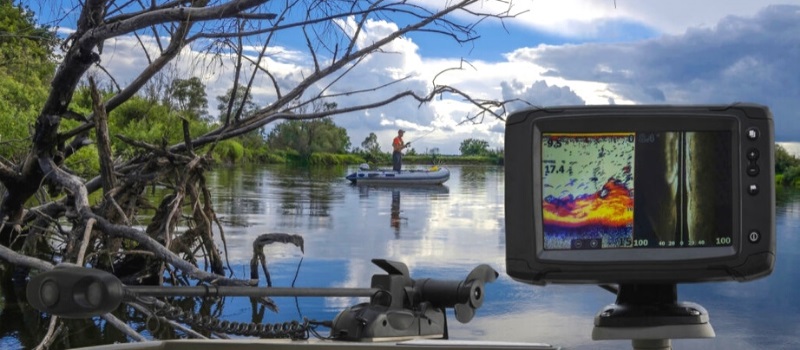
Apart from that, there are fish finder displays that present the information in colors and others only work with black and white. This is reflected in the price. However, beginners should choose color displays because they are easier to read and understand. Adjustable brightness can also be helpful on the water in sunny weather.
The functions
Not every fish finder has the same functions, so you should inspect the different models and find out about the possibilities. For example, the system side imaging is integrated with some devices, which enables you to have a side view of the underwater world. In this way, you will discover schools of fish that are some distance from the boat. Such cones, which only point downwards, would not perceive such fish.
Some fish finders are equipped with a GPS so that you can save a spot with lots of fish and quickly find it the next time you go fishing. The device stores distance traveled and enables you to analyze them after your fishing trip. Apart from a higher success, a GPS offers more security in an emergency. You can share the coordinates so that the Coast Guard can find you. But even shallow spots are easier to remember so that you can avoid dangerous places the next time.
Some devices already have stored map material for certain regions or countries. For example, if you only want to catch a specific type of fish, the map can show you in advance where you can find suitable spots with the right depth. But the map also knows dangerous places – for example, because of its shallow depth – before you leave, so that you are in turn safer.
Another function is the fish alarm; the device sends an alarm as soon as the encoder registers fish. This allows you to take the fishing trip a little more relaxed and not keep staring at the device. You will be informed immediately if there is something worth seeing on the display. This should not be confused with the depth alarm, which you can usually define yourself.
Water temperature
Many best fish finders under $300 can give you the water temperature, so the sensors are equipped with an additional sensor. The temperature can determine success and failure because every fish prefers a certain water temperature for food consumption. If the water is too cold, the metabolism of the scaly animals is automatically reduced so that the fish do not want to eat.
Some species bite better in warm and others in cold water, whereby a temperature of 8 degrees Celsius is usually a prerequisite. If you are interested in certain types of fish, a temperature sensor is a crucial function.
The technology
You can eject some donors with the fishing rod, and others must be firmly attached. Both options have their advantages and disadvantages depending on how you use them. An ejection sensor is suitable for shallow water or fishing from the shore. The encoder usually establishes a connection via Bluetooth or wireless to the data display device or smartphone. In this way, you can use the fish finder anywhere. With a fixed transducer, you have to mount it on the boat and you cannot fish with it from the shore or on another boat.
The sensor requires more transmission cones because otherwise; the area covered is too small. You don’t normally fish directly under the boat.
Power supply
The power supply is an important purchase criterion you have to consider. Most fish finders on the market use a small battery as a power supply. The same applies to the data display device, although a battery is rarely installed.
Find out in advance how long a battery charge will last. If you want to spend the entire day on the water, the battery must last at least 6 hours. You should always have spare batteries with you, but it is annoying if you have to replace the batteries three times a day. Stationary models, which you have to connect to the boat engine offer an alternative.
When using a fish finder, always make sure that both the transmitter and the visual display unit are closed properly. In the worst case, water penetrates and damages the electronics, so the device is no longer functional afterward.
The dimensions
If you decide to start fishing, lug a few things like a fishing rod, bait, survival knives, and other accessories. So it is therefore an advantage if the fish finder does not have oversized dimensions to make transportation easier for you.
Many best fish finders under $300 are already small, but the display device needs the right size. It should not be too large for good handling and not too small for better recognition. Here you have to make a few compromises in terms of image or comfort if you want a small or large device.
The data display device is ideal when it lies comfortably in the hand and still brings a good and large picture. You can easily attach some display devices to the boat or fishing rod.
The weight
Besides the size, weight is a decisive factor, which should be as low as possible. A light fish finder is helpful for transport or use. If you choose a model to attach to the boat, the weight doesn’t matter. On the other hand, if you mount the fish finder on your fishing rod, you do not want to lift a 3 kg device. After all, it depends on your use, and what weight you can carry.
The processing
A final criterion is processing, which is crucial for long shelf life. If you notice cracks, bad transitions, or cavities when you buy the fish finder, it won’t serve its purpose for long. Because electronics are installed here, they can break because of the influence of water. Even the data display device can accidentally come into contact with water so the component should be waterproof and well-processed. Therefore, take a close look at the fish finder and check weak points.
Frequently Asked Questions
How do I use the fish finder correctly?
Each model of fish finder works a little differently, which is why you must read the instructions at the beginning of unboxing. Familiarize yourself with the device and study all important information on the promising application. Only with a good understanding you can use your fish finder properly and benefit from it.
However, despite the differences, some basic functions are the same. Some fish finder models work to a depth of 100 meters and more. Others can only analyze the environment to a depth of 30 meters because the frequency of the sound waves is too low. With other devices, you have the option of setting the respective frequency. You need to know that a low frequency enables a better overview, but does not provide detailed results.
At a high frequency, you can see small fish occurrences, but the search angle is much smaller, and the overview is limited. A setting with a low frequency is suitable for optimal recognition of the fish. Once you locate fish in a zone, you can examine the area with high frequency.
What accessories are required with a fish finder?
The encoder and the display device are enough for you. The scope of delivery always includes the batteries or the rechargeable battery and instructions. With a stationary fish finder, you may still need fastening material that some manufacturers have already made available to you.
If you want to mount the data display device on the fishing rod, there are special brackets that you have to purchase separately. Otherwise, you do not need any accessories to use your fish finder, as you will receive a device in a set with all the important parts.
What types of fish finders are there?
Fish finders come in different colors, and techniques and from various manufacturers. For this reason, all models differ from each other, and yet the focus of each device is on the sensor. Success or failure depends especially on the donor, which is why we focus specifically on the sensor for the species.
Each transducer emits sound waves into the water in a certain cone. For a simplified introduction, you can compare the transmission cone of the sensor with the light of a flashlight. A flashlight scatters the light only in the area that the beam angle allows. The wider the angle of the flashlight, the more the light will capture.
The transmitter is like a flashlight and illuminates the water in a cone. As with the flashlight, the beam angle is also crucial for the sensor. Because the larger it is, the more the encoder detects it. There are different systems that are suitable for different areas of application.
How much does a good fish finder cost?
We compare fish finders from different manufacturers. The cheapest fish finder currently costs around 100 dollars. If you have more budget, you can grab the most expensive and high-quality product for around 300 to 1000 dollars. If the budget isn’t an issue for you, consider buying the feature-rich budget fish finder.
Do all fish finders under $300 come with GPS?
Not necessarily. While some fish finders in this price range include GPS functionality for navigation and marking waypoints, others may prioritize sonar technology without GPS features. Be sure to check the product specifications to ensure it meets your needs.
Can I use a cheap fish finder for ice fishing?
Yes, affordable fish finders can be used for ice fishing. However, it’s important to ensure that the fish finder you choose is suitable for ice fishing conditions. Look for models with ice fishing transducers or those that come with ice fishing accessories.
Can fish finders under $300 be used in saltwater?
Yes, many fish finders under $300 are suitable for both freshwater and saltwater fishing. However, it’s essential to choose a model with appropriate waterproofing and corrosion-resistant materials to withstand the harsh saltwater environment.
Conclusion
If you already know what type of product you want to buy, you can use the brand as the first clue to start the search. For example, if you want to buy a high-performance fish finder under 300 dollars that can be considered semi-professional, we recommend you go directly to a well-known brand.
Now you know all the information about how to choose the best fish finders under $300. Pick the one model that will meet your expectations. It’s not just us who created an article on this topic, go to your favorite search engine and search for the best cheap fish finder at this price range and you will find many articles on this topic. You can visit multiple websites and make sure you know what you are buying.
If you have any questions, you can ask in the comment section below.
- You can also check our selection of the Best Fish Finder Under 200 dollars & Buyer’s Guide. They do differ slightly on features of $300 models but largely offer the same fish finder user experience.
- Or if you want to spend a little more or have the courage to learn high-end fish finders, read the best fish finders under $500 and top quality fish finder under $1000.
